8 Configuring OCNWDAF Using CNC Console
This chapter describes how to configure different global and service parameters in Oracle Communications Networks Data Analytics Function (OCNWDAF) using the CNC Console application. OCNWDAF provides a console interface using the highly secure GUI service, which allows you to use an interactive interface for interacting with the other OCNWDAF services.
8.1 OCNWDAF GUI Login
The OCNWDAF Graphical User Interface (GUI) can be accessed only after logging in to the CNC Console application. Before proceeding, ensure that the CNC Console is installed. For more information, see "Installing OCNWDAF GUI" section of Oracle Communications Networks Data Analytics Function Installation and Fault Recovery Guide.
Before logging in to the CNC Console application, create a user name and password. For more information on user name creation, see "Configuring CNC Console IAM" section in Cloud Native Configuration Console User Guide.
Using these login credentials, you can log in to the CNC Console.
- Open a web browser and enter the URL:
http://cncc-core-ingressgateway.cncc.svc.cluster.local:port number/and press Enter.Note:
port number is thecncc-iam-ingress-portnumber.The login page opens.
Figure 8-1 CNC Console Login

- Enter the Username and Password.
- Click Log In.
- On the Console home page, select OCNWDAF instance from the Please Select Instance drop-down field.
On a new browser tab, the Slice Load Monitoring page appears.
8.2 Slice Load Monitoring
The Slice Load Monitoring screen displays the overview of the network and allows the user to perform the following actions:
- Search: A search bar is available with option to select the following filters:
- Tracking Area
- Region
- Date Range
- Logout
- See Slice Load Monitoring Threshold information.
- Obtain NF Load Monitoring information
- Obtain Geofence Monitoring information
- Access the Configuration screen (only if the user has NWDAF_WRITE access).
The following Slice Load Monitoring screen is visible to the Network Operator:
Figure 8-2 Slice Load Monitoring
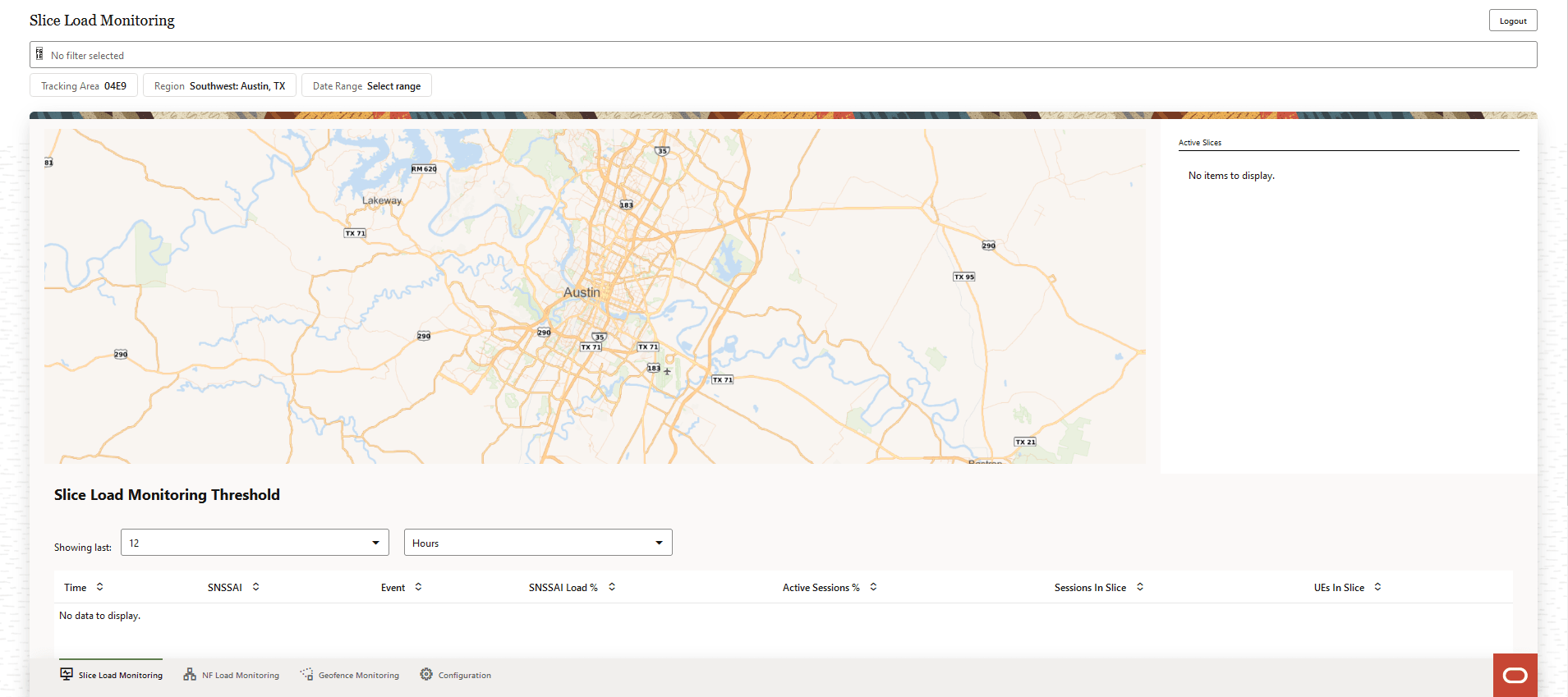
8.3 Slice Load Monitoring
Click the Slice Load Monitoring button, the following screen displays:
Figure 8-3 Slice Load Monitoring

- Active Slices
- The user can see the slice load information during a specified time duration. The time duration can be selected from the Showing last drop down list.
- Slice Load Monitoring Threshold information about the active slices:
- Time
- SNSSAI
- Event
- SNSSAI Load %
- Active Sessions %
- UEs In Slice
- Sessions In Slice
8.4 NF Load Monitoring
Click the NF Load Monitoring button, the following screen appears:
Figure 8-4 NF Load Monitoring
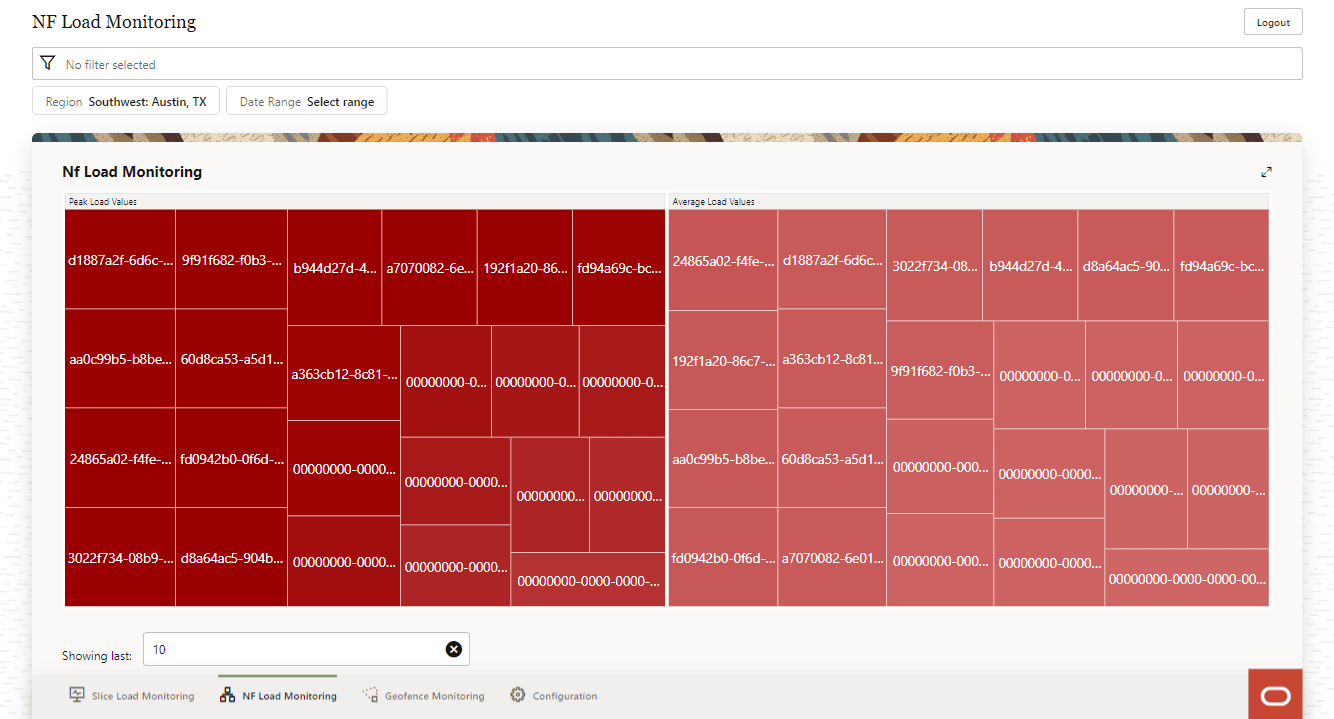
- Peak Load Values
- Average Load Values
Use the Showing last option to provide the number of previous NF loads information to be displayed on the screen.
8.5 Geofence Monitoring
Click the Geofence Monitoring button, the following screen displays:
Figure 8-5 Geofence Monitoring
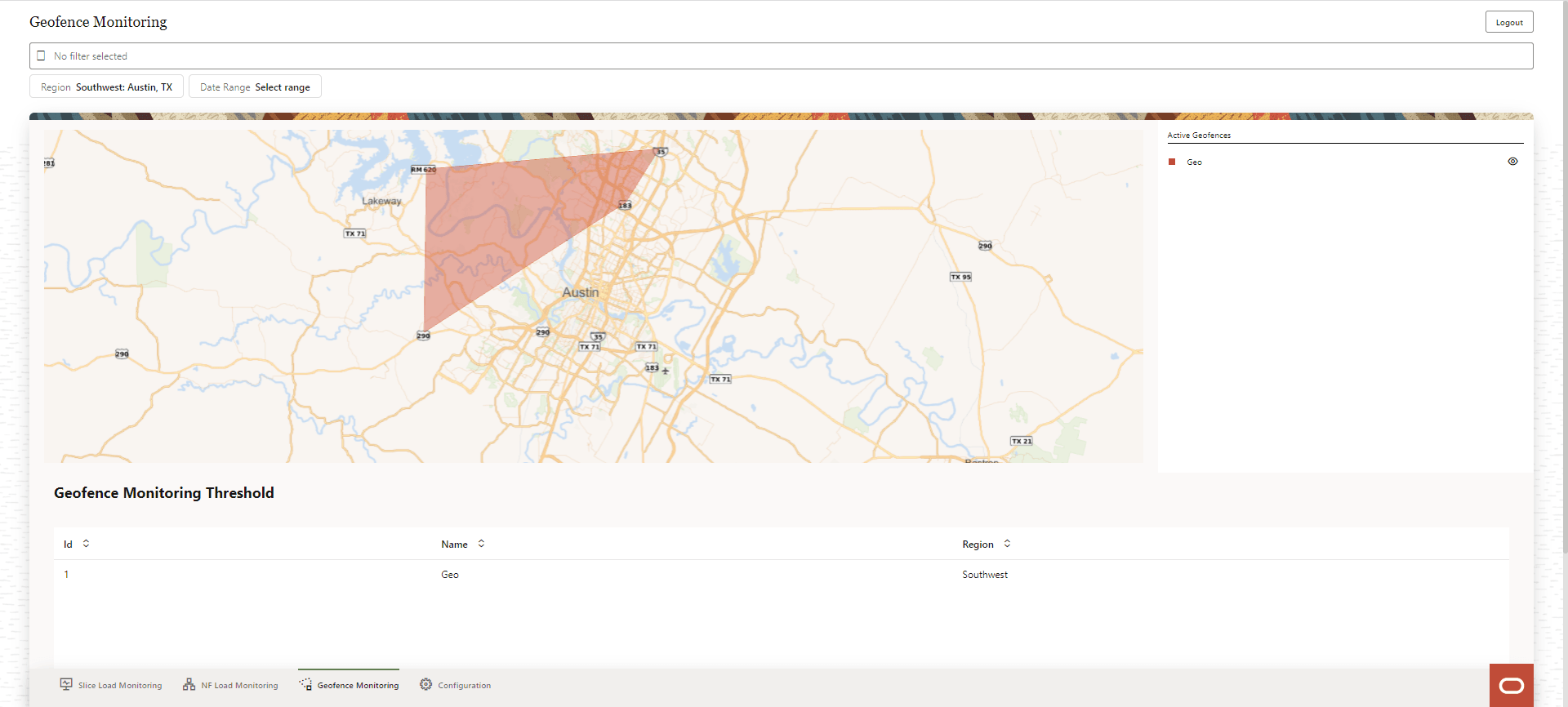
- Active Geofences
- Geofence Monitoring Threshold information about the active geofences:
- Id
- Name
- Region
8.6 OCNWDAF Configuration Page
To open the Configuration page, click Configuration button at the bottom of the Slice Load Monitoring page.
Note:
Access to the Configuration button in the Slice Load Monitoring page is available only when the user has NWDAF_WRITE access.Figure 8-6 Configuration
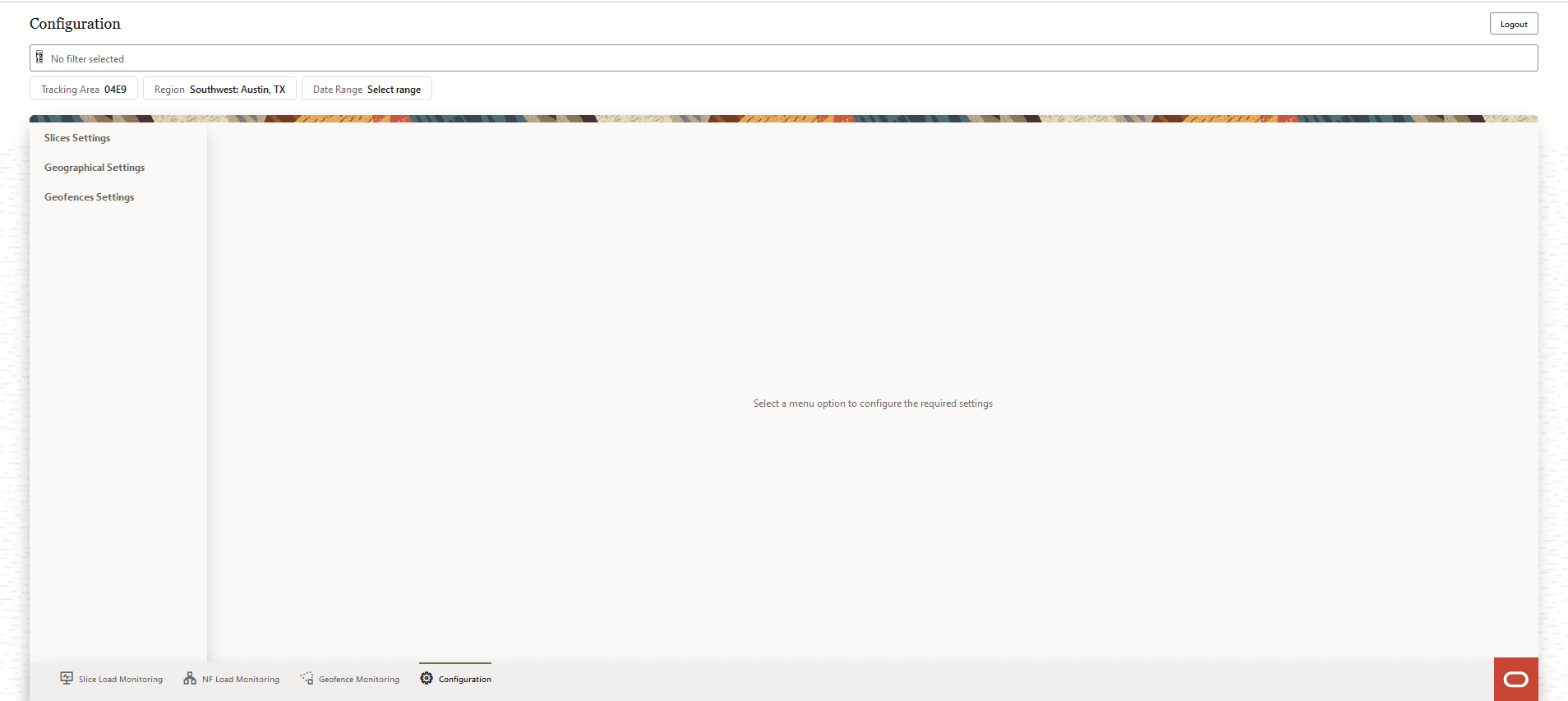
The user can perform the following actions through the Configuration page:
- Access the Slice Settings
- Access the Geographical Settings
- Access the Geofence Settings
- Logout
- Perform a search using the Search bar, by applying the following filters:
- Tracking Area
- Region
- Date Range
8.6.1 Slices Setting Screen
The Configuration screen displays the Slices Settings option. Click on the Slices Settings button, the following screen appears:
Figure 8-7 Slices Settings
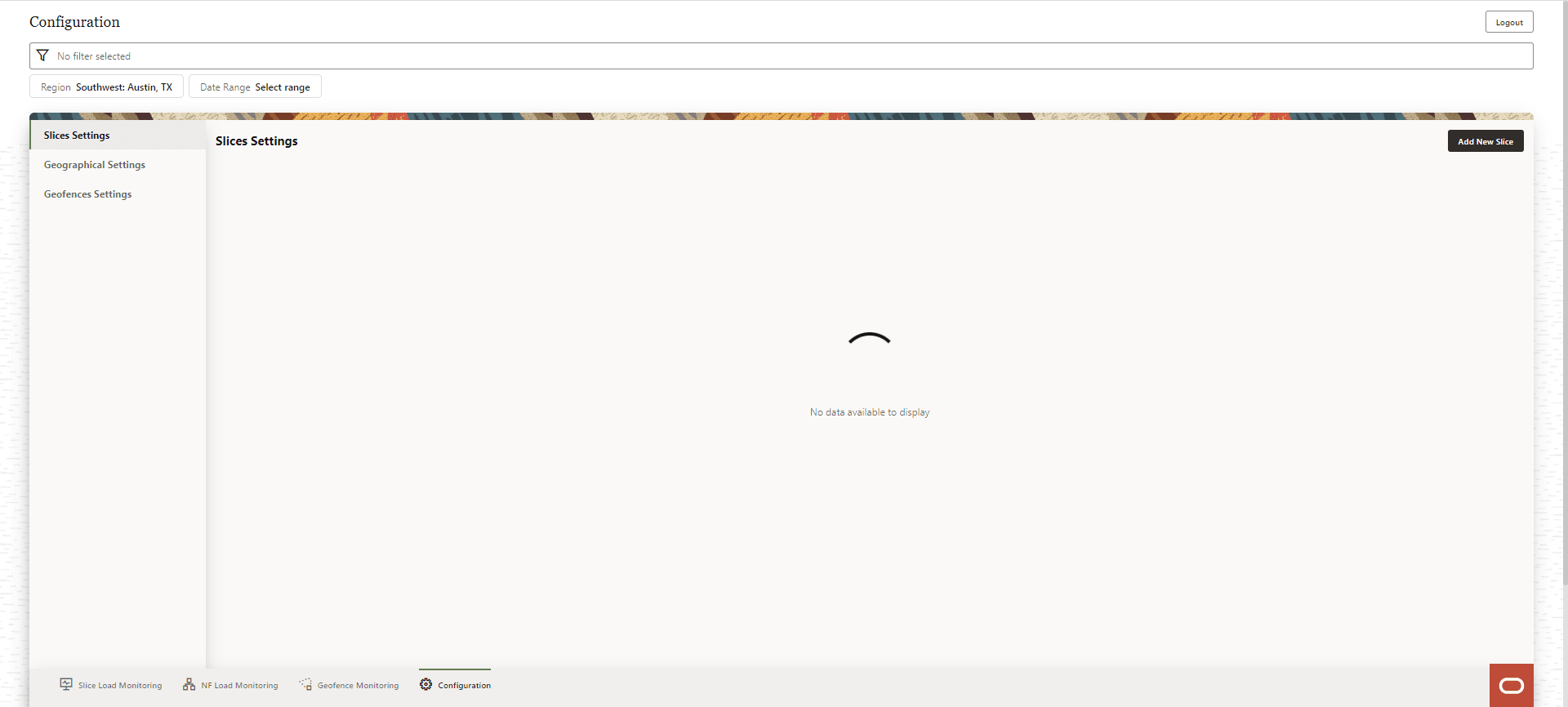
The user can perform the following actions on the Slices Settings screen:
- Add New Slice
- View the configured slices and the following slice parameters:
- Time
- S-NSSAI
- S-NSSAI Load %
- Active Sessions %
- Sessions In Slice
- UEs In Slice
- Modify existing slice information using the Edit Value button. This button appears as a pop up on clicking the three dot menu option on the right side of each configured slice listed on the screen.
- Delete an existing slice, using the Delete button. This button appears as a pop up on clicking the three dot menu option on the right side of each configured slice listed on the screen.
8.6.1.1 Add a New Slice
To add a new slice, click Add New Slice button in the Slices Settings screen. A form with the fields to add a new slice "Add Slice", appears on the right side of the screen:
Figure 8-8 Add Slice
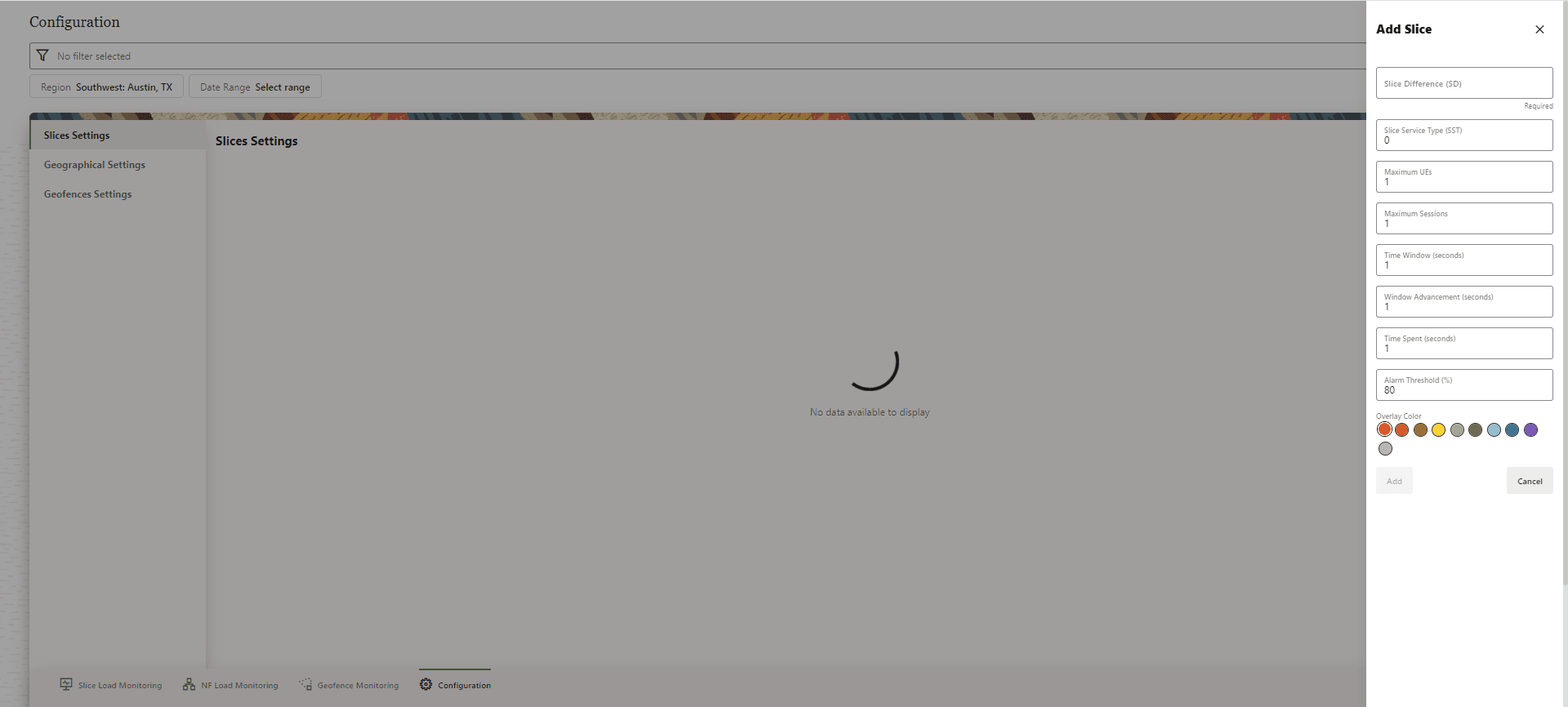
Provide the following information to create a new slice:
Table 8-1 New Slice
| Parameter | Type | Description |
|---|---|---|
| Slice Difference (SD) | String | Is a hexadecimal number (up to 6 characters) to identify different slices of the same type. |
| Slice Service Type (SST) | Unsigned integer | Value: 0 up to 127 is standardized, and 128 up to 255 is operator specific. |
| Maximum UEs | Integer | The maximum number of user equipments allowed in the slice. |
| Maximum Sessions | Integer | The maximum number of sessions allowed in the slice. |
| Time Window | Seconds | Threshold detection window time. Default: 5 minutes. |
| Window Advancement | Seconds | Threshold detection window advancement. Default: 15 seconds. |
| Time Spent | Seconds | Time spent in window opposite accepted state. |
| Overlay Color | Color | Select a display color for the slice. |
Click the Add button after entering all the fields to create a new slice. The new slice will be listed in the Slices Settings screen.
8.6.1.2 Edit an Existing Slice
To edit a slice, click dotted menu button on the right side of the slice to be edited. Click the Edit value option that appears as a pop up on the screen.
The Edit Slice form appears on the right side of the screen.
Modify the required fields to edit the slice. Click Save to apply the changes to the slice.
8.6.1.3 Delete a Slice
To delete a slice, click the three dot menu button on the right side of the slice to be deleted. A pop up appears which has an option to Delete slice.
Click Delete, a Delete Slice confirmation dialog box appears on the screen. Click Delete to confirm deletion or Cancel to cancel slice deletion.
After the slice is successfully deleted, a Success message appears on the screen.
8.6.2 Geographical Settings
The Configuration screen displays the Geographical Settings option. Click on the Geographical Settings option on the left side of the screen. The Geographical Settings screen appears.
Figure 8-9 Geographical Settings
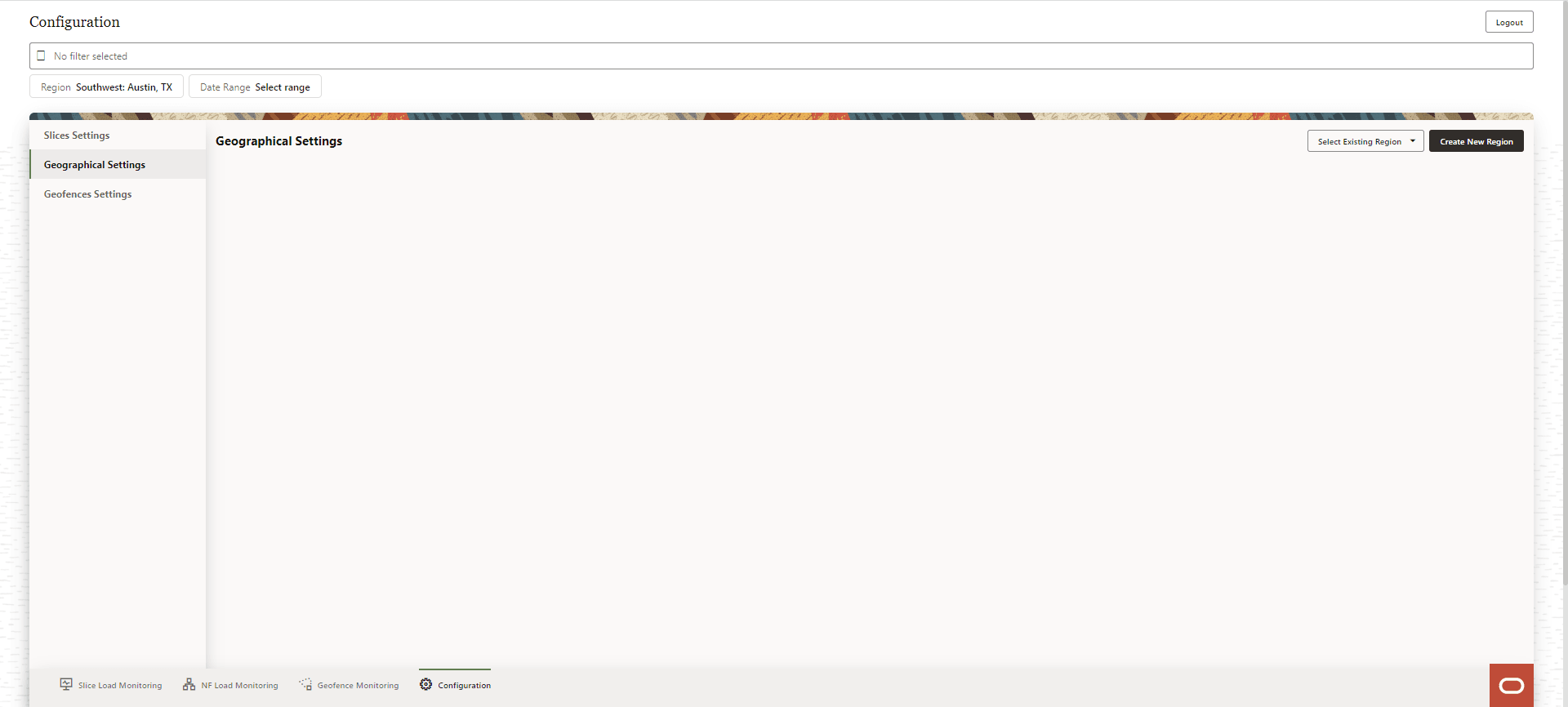
Use this screen to Select Existing Region or Create New Region.
8.6.2.1 Create New Region
Click Create New Region to create a new region.
Figure 8-10 Create New Region
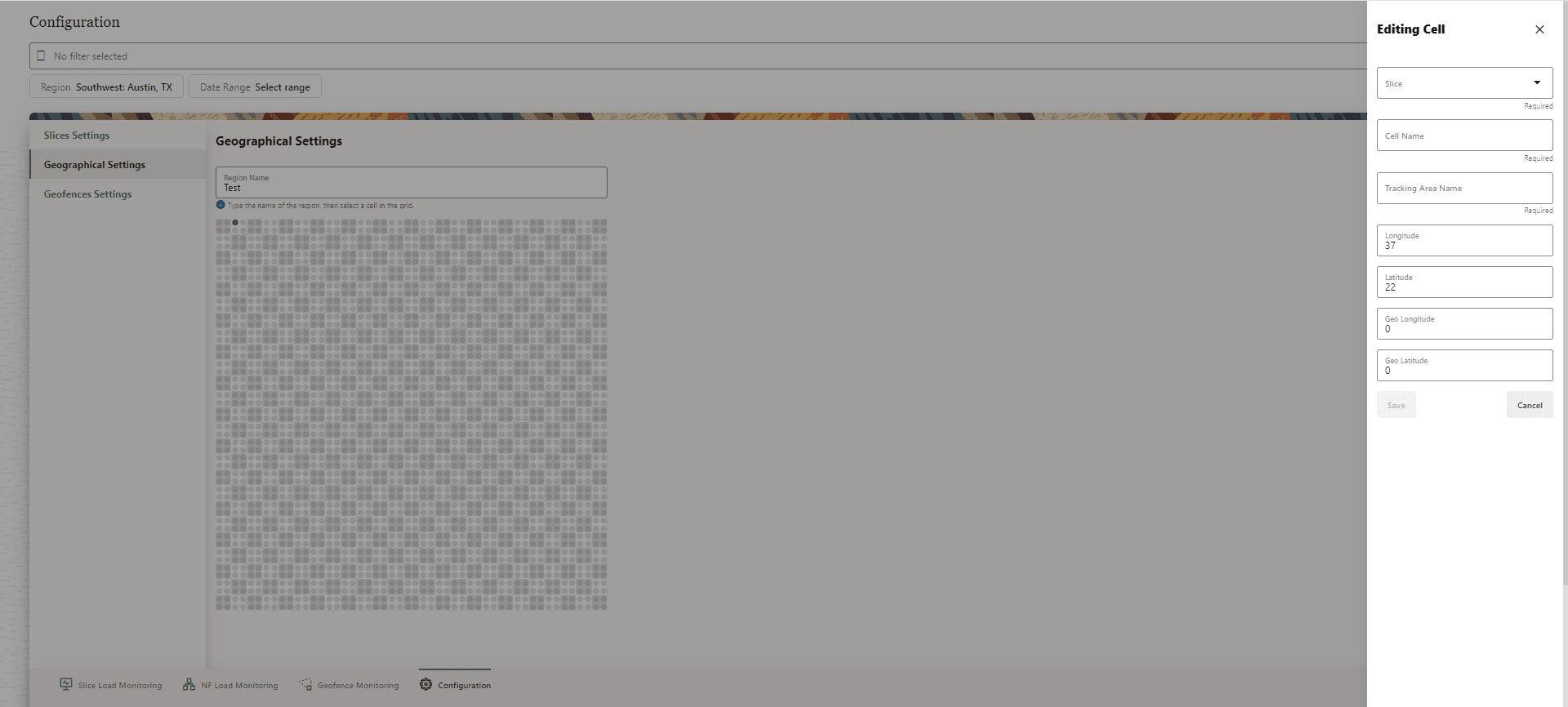
- Provide a Region Name, and then select the cell in the grid.
- The Editing Cell screen displays on the right side of the screen to update the region information. Provide the following details:
- Slice
- Cell Name
- Tracking Area Name
- Longitude
- Latitude
- Geo Longitude
- Geo Latitude
- Click Save to save the changes.
- Click Cancel to discard the changes.
8.6.2.2 Select Existing Region and Edit Cells
The Geographical Settings screen has an option to Select Existing Region. To visualize an existing region, click Select Existing Region drop down and select the desired region from the displayed list.
Figure 8-11 Existing Region
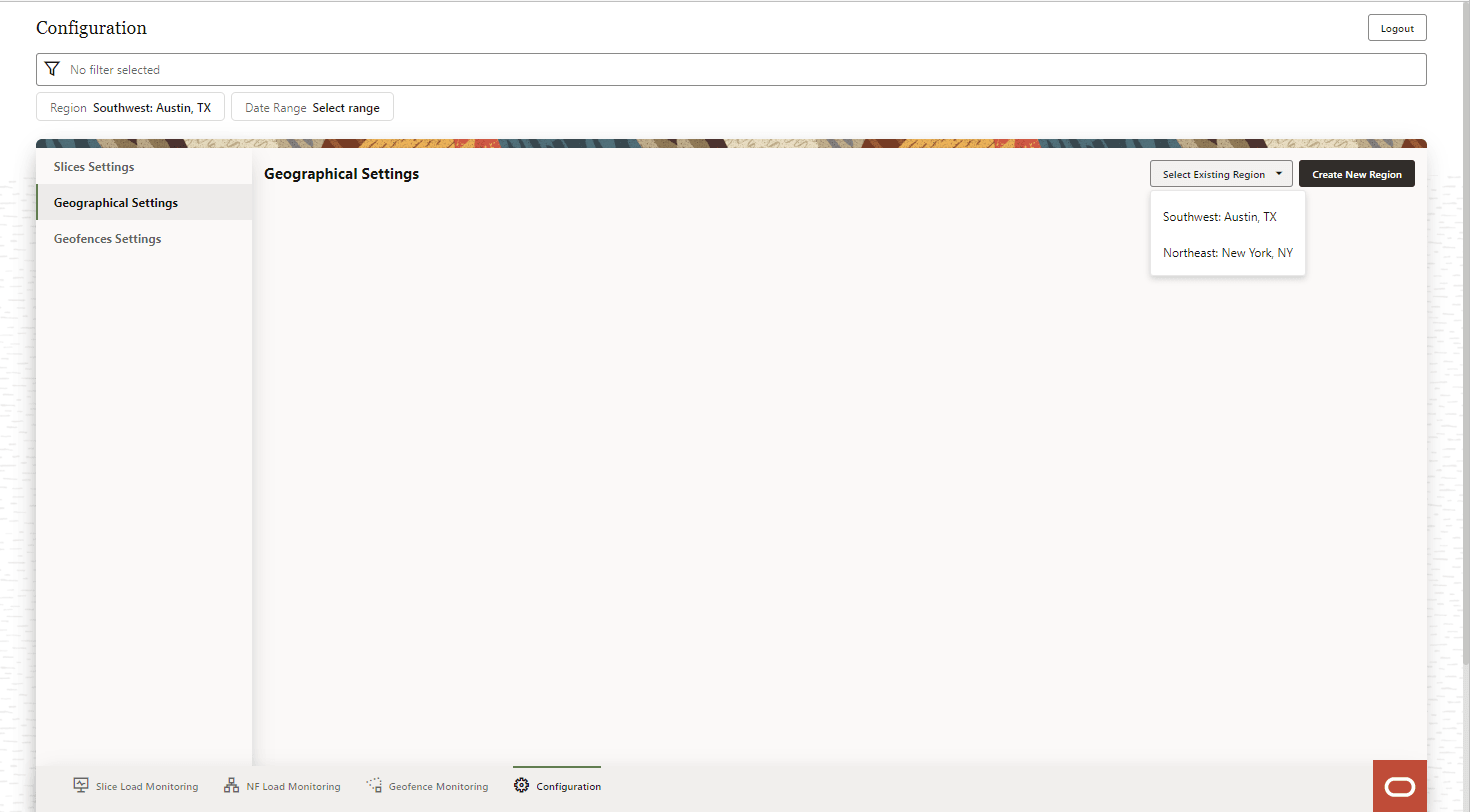
A grid of cells in the selected region are displayed, select cell that you want to edit and the Editing Cell form appears on the right side of the screen:
Figure 8-12 Edit Cell
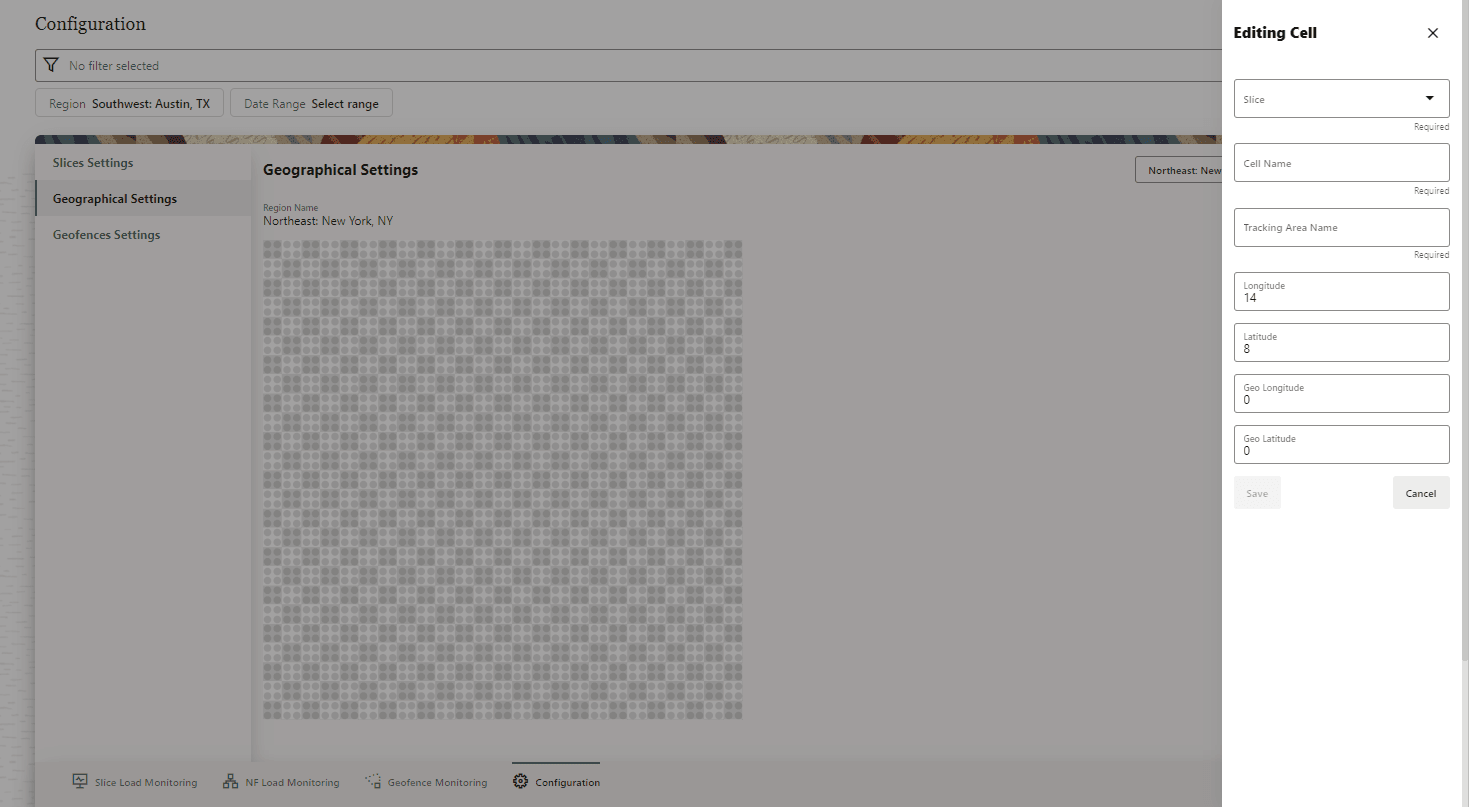
The following fields can be edited:
- Slice
- Cell Name
- Tracking Area Name
- Longitude
- Latitude
- Geo Longitude
- Geo Latitude
Click Save to save the changes or Cancel to discard the changes.
8.6.3 Geofence Settings
The Configuration screen displays the Geofences Settings option. Click on the Geofences Settings option on the left side of the screen. The Geofences Settings screen appears:
Figure 8-13 Geofences Settings

The user can perform the following actions on the Geofences Settings screen:
- Add New Geofence
- View the configured geofences and the following geofence parameters:
- Name
- Region
- Modify existing geofence information using the Edit Value button. This button appears as a pop up on clicking the three dot menu option on the right side of each configured geofence listed on the screen.
- Delete an existing geofence, using the Delete button. This button appears as a pop up on clicking the three dot menu option on the right side of each configured geofence listed on the screen.
8.6.3.1 Add New Geofence
To add a new geofence, click Add New Geofence button in the Geofence Settings screen. A form with the fields to add a new geofence "Add Geofence", appears on the right side of the screen:
Figure 8-14 Add New Geofence
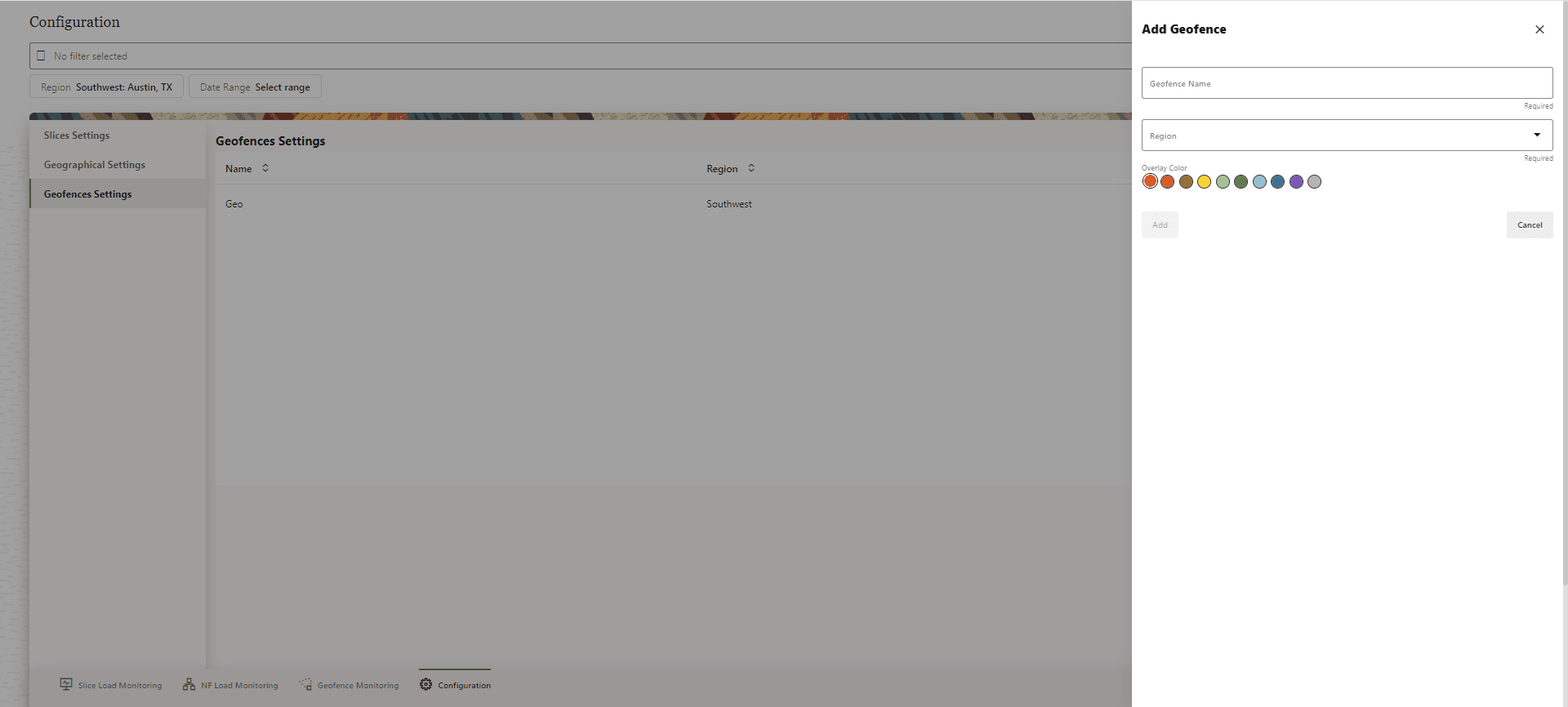
Provide the following information to create a new geofence:
- Provide a Geofence Name. This is a required field.
- Select Region from the drop-down list. A map to Draw your geofence area: appears on the screen. Select the geofence points on the map.
Figure 8-15 Draw Geofence
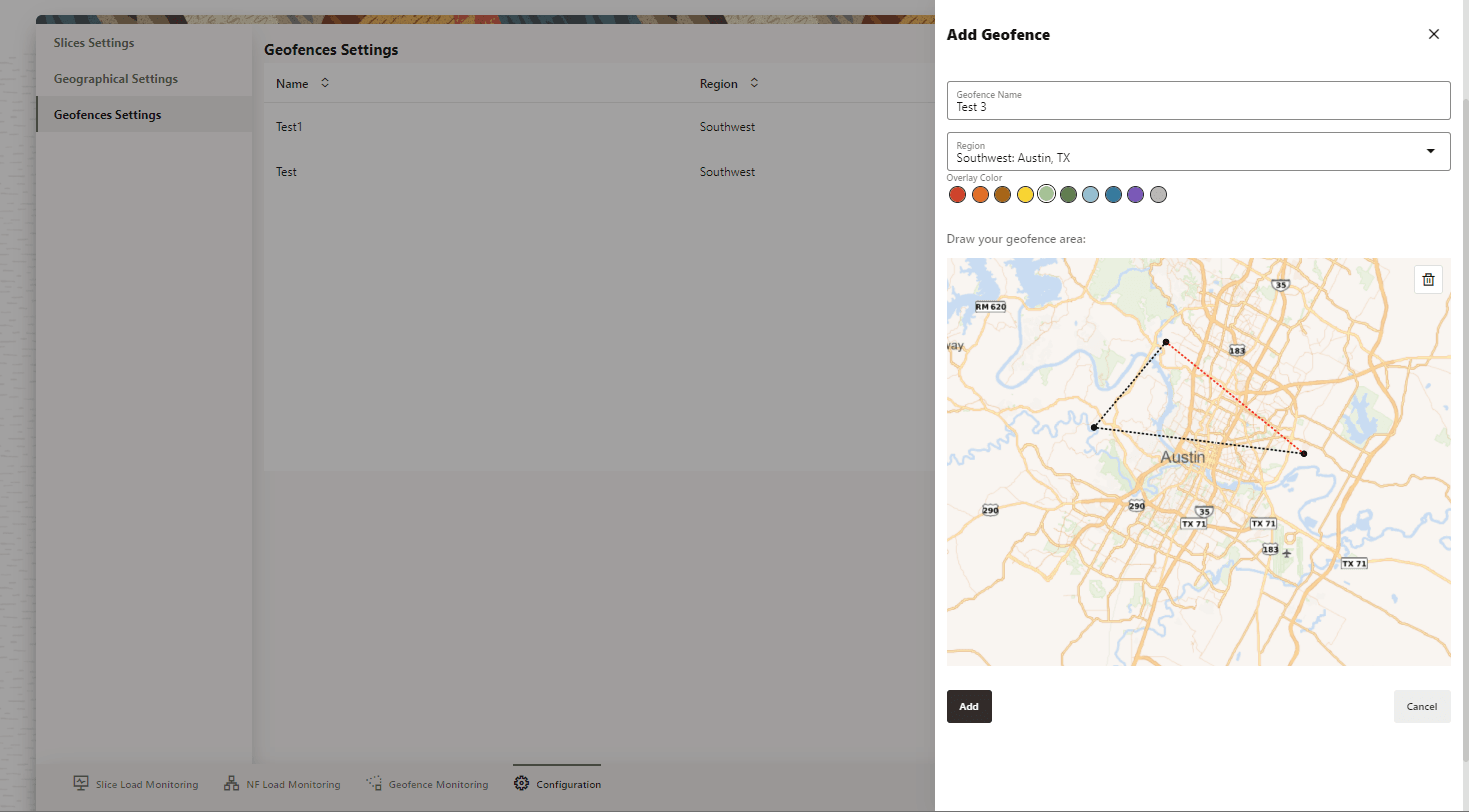
- Select an Overlay Color.
Click the Add button after entering all the fields to create a new geofence. The new geofence will be listed in the Geofence Settings screen. Click Cancel to discard the changes.
8.6.3.2 Edit Value
To edit a geofence, click dotted menu button on the right side of the geofence to be edited. Click the Edit value option that appears as a pop up on the screen.
The Edit Geofence form appears on the right side of the screen.
Modify the required fields to edit the geofence. Click Save to apply the changes to the geofence or click Cancel to discard the changes.
8.6.3.3 Delete
To delete a geofence, click the three dot menu button on the right side of the geofence to be deleted. A pop up appears which has an option to Delete geofence.
Click Delete, a Delete geofence confirmation dialog box appears on the screen. Click Delete to confirm deletion or Cancel to cancel geofence deletion.
After the geofence is successfully deleted, a Success message appears on the screen.